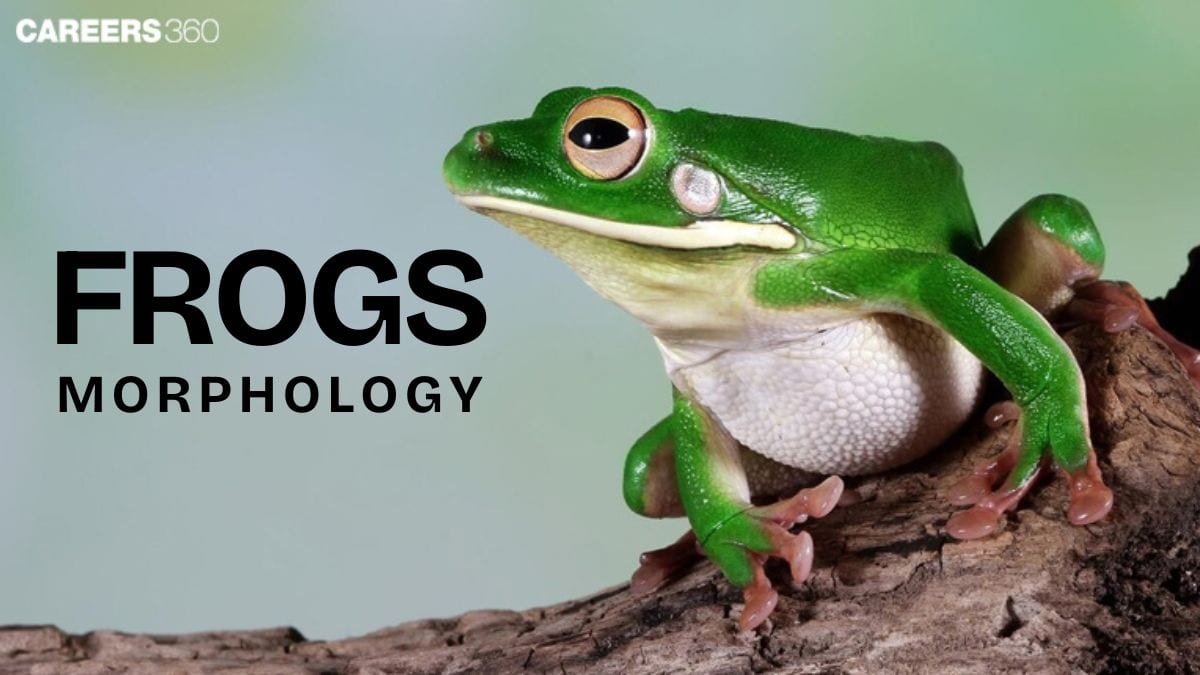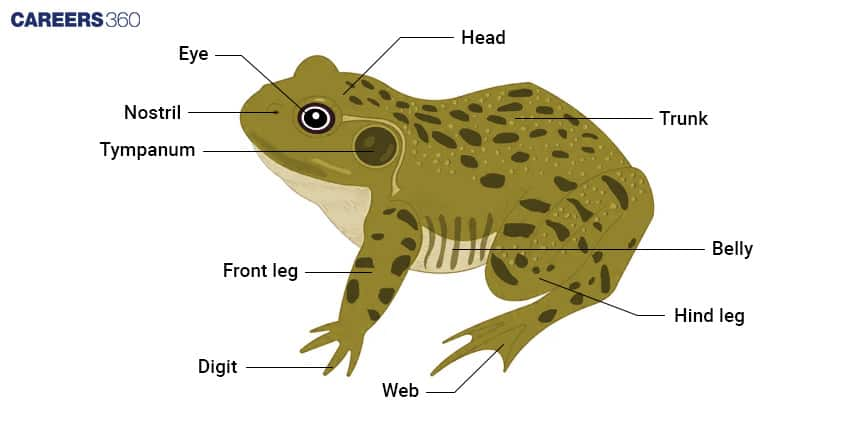Frogs: Morphology
Frogs show unique morphological and anatomical adaptations that help them survive in both aquatic and terrestrial habitats. Their features include smooth skin, webbed hind limbs, a three-chambered heart, and cutaneous respiration. Understanding the morphology of frogs—including their external features and internal anatomy—is an important topic in NEET Biology and comparative anatomy.
This Story also Contains
- Introduction to Frogs
- External Features of Frogs
- Skeletal System of Frogs
- Muscular System of Frogs
- Internal Systems of Frogs
- Frog Morphology NEET MCQs (With Answers & Explanations)
- Recommended video on "Frogs: Morphology"

Introduction to Frogs
Frogs belong to the order Amphibia and hence have been among the most exciting groups of organisms with a broad gradient of adaptations and ecological functions. Their morphology and anatomy is important to understand their life cycles and evolutionary biology. This article will present a detailed description of the anatomy of frogs about their external and internal features and try to relate them to physiological adaptations which have made them significant in an ecosystem and research.
External Features of Frogs
The external features of frogs are described below:
Their skin is smooth, and moist, and variable in colour and texture. It often works as camouflage against their native habitat.
Their head contains large, bulbous eyes set on top of the head to provide a better field of vision and a large mouth suited for capturing prey items.
Another visible, usually round, area behind the eyes is the tympanum, or ear drum—which helps them detect sound.
Frogs have sturdy, elongated hind limbs with webbed feet, which are morphological specialisations for excellent jumpers and swimmers.

Skeletal System of Frogs
The skeletal system of frogs is described below:
The skeletal anatomy in a frog consists of a bony framework that holds up the body and gives support for the different movements.
Major bones include the skull, housing the brain; the vertebral column, protecting the spinal cord; and limbs adapted to jumping and swimming.
The pelvic girdle supports the hind limbs, while the limbs in front are smaller and mainly used for support and balance.
Frogs have a much simpler skeleton compared with man, adapted to their amphibian way of life.
Muscular System of Frogs
The muscular system of frogs is described below:
The muscular system in a frog is very intricate and contains different muscles with crucial roles in movement and survival.
These major muscle groups include the powerful muscles in the hind limbs that provide the force for jumping, trunk muscles that aid swimming and burrowing, and specially adapted muscles to cope with the frog's unusual actions of jumping and swimming.
Internal Systems of Frogs
The systems of frogs are described below:
Digestive System
The frog digestive system has various complementary organs to the processes of food processing and absorption of nutrients.
Food is taken into the mouth, and after capture, sent down into the oesophagus stomach for digestion.
Then digestion further breaks it down in the intestines. The digestive system comes up with the reabsorbed nutrients employing digestive enzymes that are produced in the liver and pancreas.
Respiratory System
Frogs respire through their skin and lungs.
Moistened skin, particularly underwater, is precious to some amounts of oxygen.
Other than that, they can breathe air on land with the support of their lungs. The buccal cavity acts like a pump to push air in and out of the lungs.
Circulatory System
The frog's heart contains three chambers: two atria and one ventricle. This pumps blood throughout the body.
The system mixes blood with oxygen and without, yet is effective for its amphibian existence.
Blood passes through the heart and then the rest of the body to provide for both oxygen delivery and nutrition transport.
Excretory System
The excretory system of frogs comprises the kidneys, ureters, bladder, and cloaca.
The kidney filters waste from the blood and passes it through the ureters into the bladder for temporary storage.
Finally, the excretory products are eliminated at a common exit shared with the reproductive products: the cloaca.
Nervous System
The nervous system consists of a brain, spinal cord, and associated nerves that integrate sensory and motor activities.
The peripheral nerves and the sense organs detect changes in the environment and thereby cause responses.
Reproductive System
Frog reproduction is characterised by distinct male and female reproductive organs.
Males possess testes for producing sperm, while females possess ovaries for producing eggs.
Both reproductive systems have ducts and other structures that allow the passage or transmission of and fertilisation of organs and their functions in the life cycle of frogs.
Frog Morphology NEET MCQs (With Answers & Explanations)
Important topics that can be asked in NEET exam are:
External features of frog (skin, eyes, tympanum)
Digestive System
Excretory System
Reproductive System
Practice Questions for NEET
Q1. Which of the following statements is correct about the location of the male frog's copulatory pad?
First digit of the forelimb
First and second digit of the forelimb
First digit of the hind limb
The second digit of forelimb
Correct answer: 1) First digit of the forelimb
Explanation:
The male frogs during the breeding season develop copulatory pads, which are also known as nuptial pads. The pads are situated on the first digit (thumb) of the forelimbs. These pads help the male frog securely grasp the female during amplexus, promoting effective fertilization. The pads are black and are rough, which provides grip in the slippery aquatic environment. Their development is maintained by the hormones and serves as a secondary sexual characteristic.
Hence, the correct answer is option 1) First digit of the forelimb.
Q2. Frogs respire in water by skin and buccal cavity, and on land by skin, buccal cavity, and lungs.
The statement is false for both the environment.
The statement is true for water but false for land.
The statement is true for both environments
The statement is false for water but true for land
Correct answer: 4) The statement is false for water but true for land
Explanation:
In Water:
Frogs respire mainly through their skin (cutaneous respiration).
The buccal cavity is not used much in water, and lungs are inactive.
So, the statement is false for water.
On Land:
Frogs use skin, buccal cavity, and lungs to breathe.
So, the statement is true for land.
Hence, the correct answer is option 4) The statement is false for water but true for land.
Q3. Which type of teeth is found in frogs?
Acrodont
Homodont
Polyphyodont
All of these
Correct answer: 4) All of these
Explanation:
Acrodont, polyphyodont, and homodont teeth are all seen in frogs. This indicates that all of their teeth are of the same kind—small, pointed, and not designed for chewing. Rather, they are made to aid in retaining prey. Unlike human teeth, the teeth are acrodont which means they are affixed to the jaw directly and do not have sockets. As polyphyodonts, frogs can have many tooth replacements during their lifetime. Typically pointing backwards, the teeth aid in keeping prey from escaping. Instead of chewing their meal, frogs grasp their prey with their teeth and then swallow it whole.
Hence, the correct answer is option 4)All of these.
Also Read:
Recommended video on "Frogs: Morphology"
Frequently Asked Questions (FAQs)
The heart of the frog is three-chambered; in contrast, humans have a four-chambered heart. Frogs respire through the skin, and they have a cloaca for excretion and reproduction. In humans, these are separate systems.
The respiration in the frog occurs through the skin, lungs and buccal cavity. Frogs can respire with the help of their skin both in water and on land.
The heart structure in a frog is three-chambered with two atria and one ventricle.
The frogs have well-developed sex organs of male and female sexes. The reproduction is exogenous; the female lays eggs in the water, which are then fertilized by the male.
Frogs have smooth, moist skin, bulging eyes, a wide mouth, a tympanum and webbed feet.